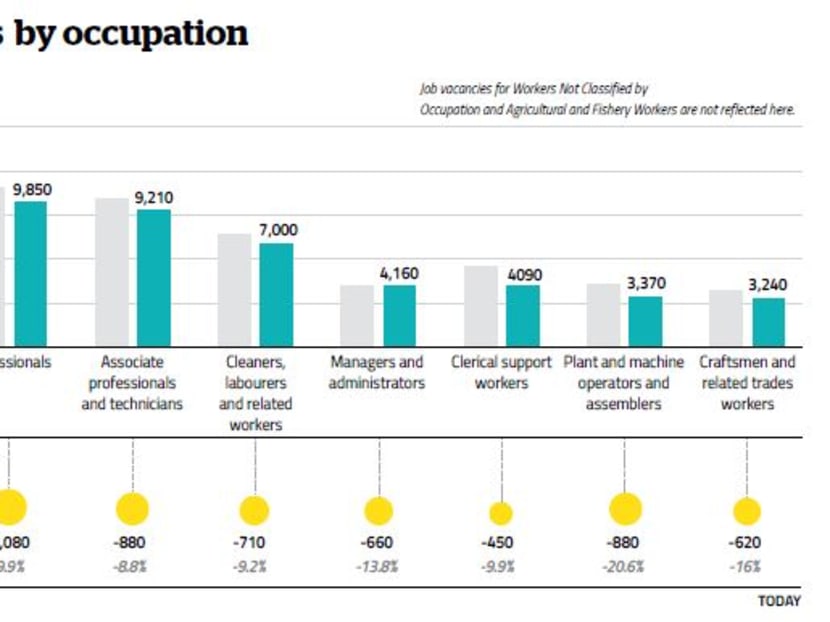More vacancies than jobseekers, but gap narrowing
SINGAPORE — While the number of job openings continued to outnumber jobseekers last year, the gap has narrowed for the second straight quarter, latest statistics from the Ministry of Manpower (MOM) show.
SINGAPORE — While the number of job openings continued to outnumber jobseekers last year, the gap has narrowed for the second straight quarter, latest statistics from the Ministry of Manpower (MOM) show.
As of September last year, there were 116 jobs to every 100 applicants, compared with 141 jobs for every 100 applicants during the same period in 2014. And economists caution that the positive situation could be due to a mismatch between what jobseekers wanted and which sectors were actually hiring, and warned that the soft economic outlook could mean more retrenchments in the coming year.
Manpower Minister Lim Swee Say, speaking on the sidelines of a company visit today (Feb 3), also flagged the structural mismatch in the hiring situation for professionals, managers, executives and technicians (PMETs). Initiatives — including the SkillsFuture movement — were in place to address the situation, he said.
Last week, figures released by the MOM showed the slowest employment growth — 0.9 per cent —since 2003, amid gloomy economic conditions and the clampdown on foreign manpower supply, but Mr Lim had noted the rise in real median income and the tight labour market conditions.
Commenting on the job vacancies report released today, he reiterated that the situation is “still healthy” but said that as the economy undergoes restructuring, both job growth and workforce growth will slow.
Noting that there were more job vacancies than people looking for work, Mr Lim said the Government is “very interested” in finding out why the openings are not matched with job seekers. He cited feedback that many employers were unable to find the workers they need because wages and working conditions were not attractive enough. This is especially so for non-PMET jobs, he said. The solution is for the companies to enhance the quality of the jobs and redesign them, he added.
(click on image to enlarge)

The MOM’s concern is “not just about making sure (there are) enough jobs for the workers”, Mr Lim stressed. “But more importantly, looking into the future, our greater concern will be: Can we maximise the matching between (openings and jobseekers)... can we make every job a better job, can we make every worker a better worker, and how we can find an effective way to bring them together.” Achieving this would require the concerted efforts of the tripartite partners, he reiterated.
The number of job openings has outnumbered job seekers since June 2012, while in 2009, during the global financial crisis, the ratio was less than 1 for the entire year.
The total number of job vacancies as of September last year stood at 60,000, down from a peak of 67,400 a year ago. Seasonally-adjusted, the figure was 55,600, down for the third consecutive quarter.
Of the vacancies, four in ten were for PMETs, led by the teaching and training line. Service and sales workers had the second-largest number of job vacancies, comprising over 20 per cent of total job vacancies.
Still, all occupations saw a decline. The MOM said that due to “softer demand from domestic-oriented sectors of retail trade and administrative and support services”, there have been fewer openings for positions like shop sales assistants and cashiers. The ministry also noted that the weak manufacturing demand had spilled over to the transportation and storage sector, and dampened demand for positions such as plant and machine operators.
The report also showed that jobs were being filled up faster than before, although non-PMET openings were generally harder to fill as compared to PMET openings. Close to 60 per cent of vacancies for jobs like cleaners and service and sales workers were unfilled for at least six months.
Employers cited reasons such as unattractive pay and long working hours as challenges to recruiting locals for non-PMET roles, while pay and the lack of experience were obstacles to hiring locals for PMETs positions.
SIM University senior lecturer Walter Theseira pointed out that the ratio of job openings to job seekers is still “significantly above” the figure seen during the financial crisis.
But sectors exposed to falling oil prices, the slump in the commodities market and the slowing Chinese economy are likely to be affected, he said. “What’s more important though for job seekers is whether there are excess openings or openings at all in their desired areas of work,” he added.
Agreeing, Mizuho Bank senior economist Vishnu Varathan said job mismatch was an issue, adding that availability of jobs such as in the cleaning or security should not be interpreted as job market strength.
Barclays senior regional economist Leong Wai Ho said that if the economy continues to cool, the ratio of jobs to seekers “might be close to parity” or decline further in the first quarter of this year.
He noted that the boost in demand for services last year due to tourism, financial services and commodities trading activities will likely weaken early this year, and the services sector may not grow sufficiently to offset the continued slowdown in manufacturing. There could also be more lay-offs compared to last year. ADDITIONAL REPORTING BY CLIFFORD LEE







